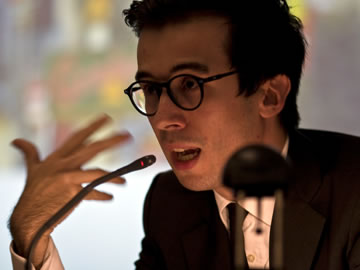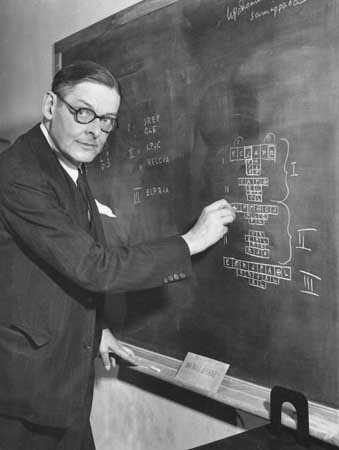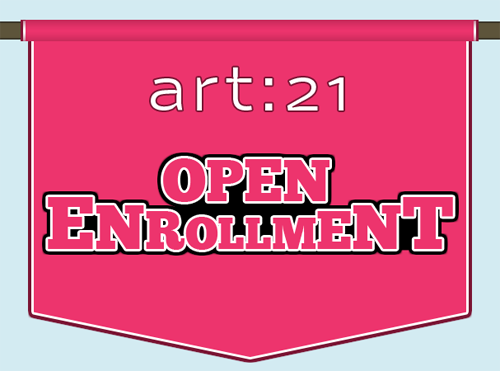What defines “the contemporary” as an area of study? How does it relate to the writing of history or other fields of inquiry? In this edition of Open Enrollment, Oliver Wunsch, a graduate student in history of art at Williams College, speaks about these questions and more with João Ribas, Curator at the List Visual Arts Center at MIT. Ribas was previously Curator at The Drawing Center in New York, and has organized over thirty exhibitions in the US and abroad. He is the winner of two consecutive International Association of Art Critics Awards, and his writing appears in numerous publications.

João Ribas | Photo: Mario Heuschober, © Secession 2008
Oliver Wunsch: This Open Enrollment column deals with the questions and concerns of graduate students in the arts. In part, I was interested in speaking with you because you’re 31 years old and have a long professional record. During the years when many people pursuing a career in the arts would be in grad school, you were working as a writer and curator. To begin with beginnings, how did you start down this path?
João Ribas: I started through the practice of writing criticism — what I thought I’d be doing was focusing on post-war thought and contemporary art through academic work, though I became increasingly involved in the “contemporary art” part of the pairing, and so [became] an art critic and editor instead. Only later did I become involved with curatorial practice. That came with an interest in the discursive, narrative, and dramaturgical space of an exhibition, rather than the more analytical or reflective aspect of writing. What interested me at first was the production of a critical, judgment-based discourse, the kind of writing that exists before more sclerotic methodologies take over — maybe because of the aversion academic orthodoxy still maintains towards such belle-lettrist tendencies, like [Charles] Baudelaire writing on [Constantin] Guys.
OW: Do you see your time as a critic as part of your education?

Clement Greenberg
JR: Clement Greenberg, for all the polemics he entrains, called it “learning in public” — this sense of writing as a heuristic to discover what you think, as well as the gnawing fear of having to repudiate one’s previous judgments. What interested me was the reflective judgment enacted in the act of writing, itself part of the process of constantly seeing art. In the process of writing, you are forced to come to terms with something — like [Paul] Valery turning the seashell in his hands — and the object of your criticism is either less or more favored than when you first started, sometimes for altogether different reasons.
OW: “Art historians are slow critics,” according to Thierry de Duve. I’m interested to hear more about how your work relates to history since you’ve mentioned that an emerging historical narrative about contemporary art drew you to the field. Can you speak more about how a sense of history played a role in your intellectual development?
JR: My involvement in curatorial work was somewhat concurrent with the field becoming more and more “visible” — that is, coming to historicize itself along the lines of constituting a discipline. This project of a historiography of curating, or writing the history of curatorial practice, as well as an attention to the role exhibitions played in 20th century art history, was under way. What the production of this history continues to show is the role curatorial work plays in the contextualization, and eventual historicization, of contemporary artistic production. At the same time, as the field began to produce this history, there was a rise of new kinds of art that challenged the normative assumptions of precisely that historical narrative. Those methodologies were, and continue to be, largely put in place by new generations of curators working with new generations of artists. This relationship is significant: it shows how curatorial work — meaning the production of exhibitions and its related discourse — operates in a state of critical in-between-ness — say the supposed logic of the market and the art historical process — and in effect produces the interpretative horizon for what we deem the “contemporary.” [Daniel-Henry] Kahnweiler thought museums had no business collecting or largely exhibiting art by living artists — this less than a century ago; it’s only recently that contemporary topics are generally accepted in the field of art history. I think the ongoing historiography of curating demonstrates the significant role it has played in producing what we call “contemporary art history” as a result, and I was interested in the temporality and historicity of that.
OW: I have heard a lot, particularly from professors, about the explosion of interest in contemporary art amongst a younger generation. Applicants to graduate programs in the history of art increasingly gravitate towards modern and contemporary subject matter. Do you have any guesses as to the origins of this?

Paris Poster, May 1968
JR: I’d think you’d have to look at the relationship of that interest to the two singular events that seem to structure the political and cultural imaginaries of that generation, namely 1968 and 1989. The latter is perhaps the most significant political transformation that defines it, in which the major ideological pivot of previous decades is no longer part of political life and where, as historical subjects, they are supposedly at “the end of history” and the universalization of western liberal democracy. So this generation is a product of the enormous benefits of those changes of the post-war world — at least until about 22 months ago — while dealing with its geopolitical consequences. Yet the event that most defines the cultural imaginary of that same generation, I would argue, is actually 1968. The most common references in the art world, in terms of texts cited and buzzwords quoted are those central to, and of, the generation of ’68 ([Walter] Benjamin, Situationism, [Gilles] Deleuze, [Antonio] Negri, [Michel] de Certeau, [Michel] Foucault, etc…) Even the aesthetics of politicized art is largely the aesthetics of the politics of the 1960s. So there is a tension with our cultural imaginary, which structures our aesthetic modalities of thinking and doing, and our historical and political condition. This is not to say that art is drained of political agency, but that the politics that define our present condition are not those of the aesthetic language that is dominant, namely, that of the 1960s — collective social revolution, or revolutionary spontaneity, for example. Yet the aesthetic aspect tied to those politics somehow still survives as the lingua franca of contemporary art — without say, a clear directive of how the Left can reconstitute itself in light of the post-communist world.
OW: Can you say more about this tension?
JR: This generation you mention being interested in contemporary art as a field is also a generation whose visual language seems established through the “second event” of the 1960s: the historicization of its ideology, language, texts, and images. To be precise, what I think you are talking about is mostly a new academic interest in the art of that time, precisely the same era being historicized within museums and institutions, and which serves as the basis for the aesthetic vocabulary of much of contemporary art production—as well as the critical language brought to it. James Meyer has pointed out how central the 1960s are to the cultural identifications of contemporary artists. As a result, I think we need to expand the critical models and bring new language to that conversation.
OW: What role can university exhibition spaces play in dealing with this idea of the contemporary?
JR: What interests me in those types of spaces is the potential for contemporary artistic production to be treated as a field in which knowledge is produced, and for engaging models of how that knowledge might be constituted. How can contemporary art be engaged as a field of inquiry, and how does it relate to other disciplines and forms? Right now, the university art museum can also become a site to deal with another issue, the extent to which we have given up the arc of an artistic career to the market.

T. S. Eliot
OW: In concluding, I want to ask you about this T. S. Eliot line that I have seen you quote: “Where is the knowledge that we have lost in information?”
JR: I was really interested in the theorizing about media that seemed to lead to the conclusion that there was an economics of attention created by an overabundance of information. This was coupled with the fact that there seemed to be a lot of discussion about artists working with a kind of metaphysical slant, or press releases with staid language describing how such and such artist “alters our perception of the mundane.” Eliot just seems to encapsulate that idea very early, this pervasive idea in our cultural conversation that what we think of as knowledge is being lost, and replaced by information.





Pingback: Society of Contemporary Art Historians | Oliver Wunsch interviews João Ribas